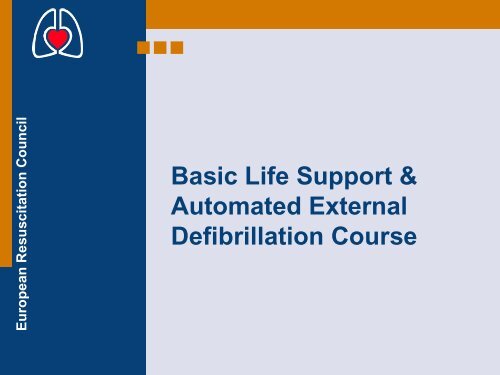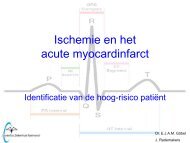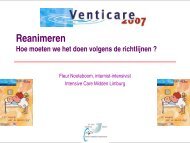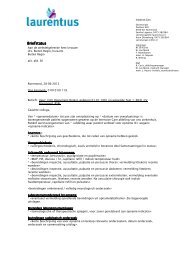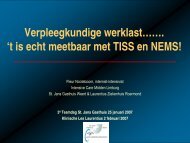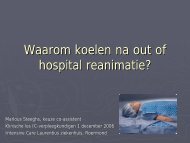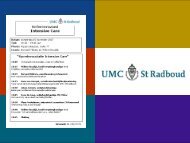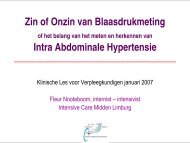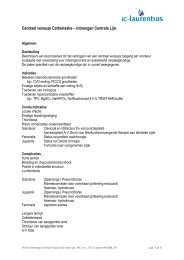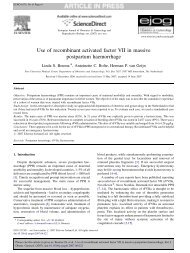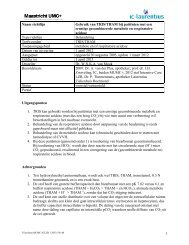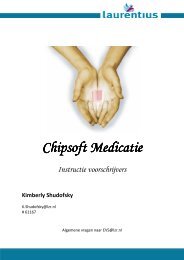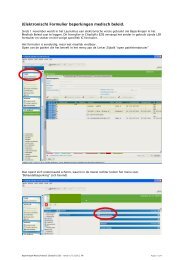European Resuscitation Council
European Resuscitation Council
European Resuscitation Council
Create successful ePaper yourself
Turn your PDF publications into a flip-book with our unique Google optimized e-Paper software.
<strong>European</strong> <strong>Resuscitation</strong> <strong>Council</strong>Basic Life Support &Automated ExternalDefibrillation Course
OBJECTIVES<strong>European</strong> <strong>Resuscitation</strong> <strong>Council</strong>• At the end of this courseparticipants should be able to demonstrate:– How to assess the collapsed victim.– How to perform chest compression and rescuebreathing.– How to operate an automated external defibrillatorsafely.– How to place an unconscious breathing victim in therecovery position.
BACKGROUND<strong>European</strong> <strong>Resuscitation</strong> <strong>Council</strong>• Approximately 700,000 cardiac arrests per yearin Europe• Survival to hospital discharge presentlyapproximately 5-10%• Bystander CPR vital intervention before arrival ofemergency services• Early resuscitation and prompt defibrillation(within 1-2 minutes) can result in >60% survival
CHAIN OF SURVIVAL<strong>European</strong> <strong>Resuscitation</strong> <strong>Council</strong>
Approach safely<strong>European</strong> <strong>Resuscitation</strong> <strong>Council</strong>Check responseShout for helpOpen airwayCheck breathingCall 11230 chest compressions2 rescue breaths
APPROACH SAFELY!<strong>European</strong> <strong>Resuscitation</strong> <strong>Council</strong>SceneRescuerVictimBystandersApproach safelyCheck responseShout for helpOpen airwayCheck breathingCall 11230 chest compressions2 rescue breaths
CHECK RESPONSE<strong>European</strong> <strong>Resuscitation</strong> <strong>Council</strong>Approach safelyCheck responseShout for helpOpen airwayCheck breathingCall 11230 chest compressions2 rescue breaths
CHECK RESPONSE<strong>European</strong> <strong>Resuscitation</strong> <strong>Council</strong>Shake shoulders gentlyAsk “Are you all right?”If he responds• Leave as you find him.• Find out what is wrong.• Reassess regularly.
SHOUT FOR HELP<strong>European</strong> <strong>Resuscitation</strong> <strong>Council</strong>Approach safelyCheck responseShout for helpOpen airwayCheck breathingCall 11230 chest compressions2 rescue breaths
OPEN AIRWAY<strong>European</strong> <strong>Resuscitation</strong> <strong>Council</strong>Approach safelyCheck responseShout for helpOpen airwayCheck breathingCall 11230 chest compressions2 rescue breaths
CHECK BREATHING<strong>European</strong> <strong>Resuscitation</strong> <strong>Council</strong>Approach safelyCheck responseShout for helpOpen airwayCheck breathingCall 11230 chest compressions2 rescue breaths
CHECK BREATHING<strong>European</strong> <strong>Resuscitation</strong> <strong>Council</strong>• Look, listen and feelfor NORMALbreathing• Do not confuseagonal breathing withNORMAL breathing
AGONAL BREATHING<strong>European</strong> <strong>Resuscitation</strong> <strong>Council</strong>• Occurs shortly after the heart stopsin up to 40% of cardiac arrests• Described as barely, heavy, noisy orgasping breathing• Recognise as a sign of cardiac arrest
<strong>European</strong> <strong>Resuscitation</strong> <strong>Council</strong>Approach safelyCheck responseShout for helpOpen airwayCheck breathingCall 11230 chest compressions2 rescue breaths
30 CHEST COMPRESSIONS<strong>European</strong> <strong>Resuscitation</strong> <strong>Council</strong>Approach safelyCheck responseShout for helpOpen airwayCheck breathingCall 11230 chest compressions2 rescue breaths
CHEST COMPRESSIONS<strong>European</strong> <strong>Resuscitation</strong> <strong>Council</strong>• Place the heel of one hand inthe centre of the chest• Place other hand on top• Interlock fingers• Compress the chest– Rate 100 min -1– Depth 4-5 cm– Equal compression : relaxation• When possible change CPRoperator every 2 min
RESCUE BREATHS<strong>European</strong> <strong>Resuscitation</strong> <strong>Council</strong>Approach safelyCheck responseShout for helpOpen airwayCheck breathingCall 11230 chest compressions2 rescue breaths
RESCUE BREATHS<strong>European</strong> <strong>Resuscitation</strong> <strong>Council</strong>• Pinch the nose• Take a normal breath• Place lips over mouth• Blow until the chestrises• Take about 1 second• Allow chest to fall• Repeat
CONTINUE CPR30 2<strong>European</strong> <strong>Resuscitation</strong> <strong>Council</strong>
Approach safely<strong>European</strong> <strong>Resuscitation</strong> <strong>Council</strong>Check responseShout for helpOpen airwayCheck breathingCall 11230 chest compressions2 rescue breaths
DEFIBRILLATION<strong>European</strong> <strong>Resuscitation</strong> <strong>Council</strong>
Approach safely<strong>European</strong> <strong>Resuscitation</strong> <strong>Council</strong>Check responseShout for helpOpen airwayCheck breathingCall 112Attach AEDFollow voice prompts
SWITCH ON AED<strong>European</strong> <strong>Resuscitation</strong> <strong>Council</strong>• Some AEDs willautomatically switchthemselves on whenthe lid is opened
ATTACH PADS TOCASUALTY’S BARE CHEST<strong>European</strong> <strong>Resuscitation</strong> <strong>Council</strong>
ANALYSING RHYTHMDO NOT TOUCH VICTIM<strong>European</strong> <strong>Resuscitation</strong> <strong>Council</strong>
SHOCK INDICATED• Stand clear• Deliver shock<strong>European</strong> <strong>Resuscitation</strong> <strong>Council</strong>
SHOCK DELIVEREDFOLLOW AED INSTRUCTIONS30 2<strong>European</strong> <strong>Resuscitation</strong> <strong>Council</strong>
NO SHOCK ADVISEDFOLLOW AED INSTRUCTIONS30 2<strong>European</strong> <strong>Resuscitation</strong> <strong>Council</strong>
<strong>European</strong> <strong>Resuscitation</strong> <strong>Council</strong>IF VICTIM STARTS TOBREATHE NORMALLY PLACEIN RECOVERY POSITION
<strong>European</strong> <strong>Resuscitation</strong> <strong>Council</strong>
CPR IN CHILDREN<strong>European</strong> <strong>Resuscitation</strong> <strong>Council</strong>• Adult CPRtechniques can beused on children• Compressions 1/3 ofthe depth of the chest
AED IN CHILDREN<strong>European</strong> <strong>Resuscitation</strong> <strong>Council</strong>• Age > 8 years• use adult AED• Age 1-8 years• use paediatric pads /settings if available(otherwise use adultmode)• Age < 1 year• use only ifmanufacturerinstructions indicate itis safe
ANY QUESTIONS?<strong>European</strong> <strong>Resuscitation</strong> <strong>Council</strong>
<strong>European</strong> <strong>Resuscitation</strong> <strong>Council</strong>Approach safelyCheck responseShout for helpOpen airwayCheck breathingCall 11230 chest compressionsApproach safelyCheck responseShout for helpOpen airwayCheck breathingCall 112Attach AED2 rescue breathsFollow voice prompts


